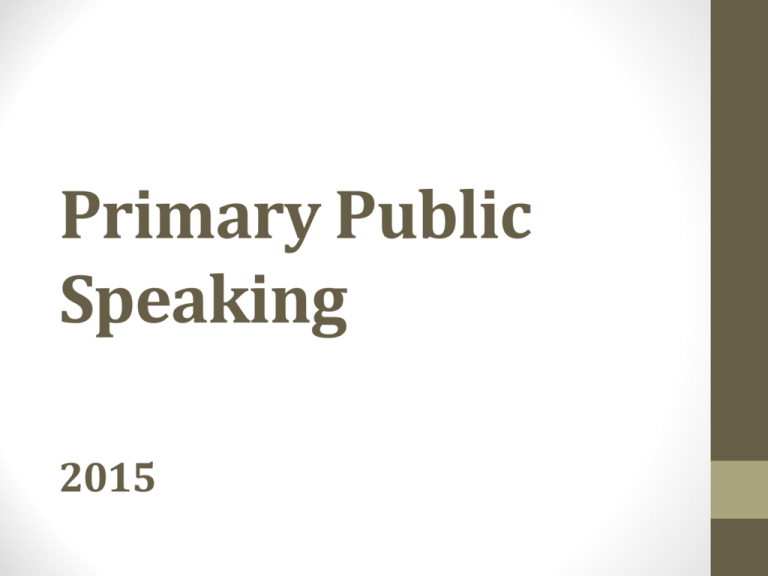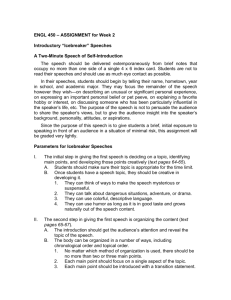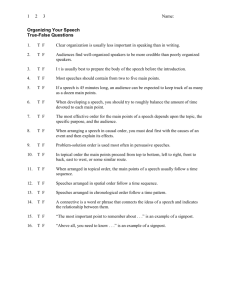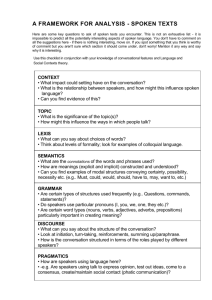Public Speaking - Connells Point Public School
advertisement

Primary Public Speaking 2015 WHEN TO START - COMMENTS The best way to learn just about any skill in life is to start at the earliest age possible. It doesn't seem to matter if the subject is cooking, playing a musical instrument, sports, or public speaking, starting young seems to reap huge benefits. Comments • If there is one thing I regret in my life it is the inability to speak comfortably in front of any more than 2 people at the same time. • Even to this day, just the thought of speaking in front of a group strikes terror into my heart. • When I think back to the school years, I realise that public speaking must have been a skill that was not considered important for students to learn. At least not properly. FURTHER COMMENTS • if you are taught something in the formative years, it tends to become second nature. Like writing for instance. • Could you imagine teaching a student to write beginning in year 9? How much sense would that make? • Why don't we have that same thought process with public speaking? It would easily be one of the most valuable skills ever learned in the school years. Public speaking can be the source of significant anxiety for children and for adults. Many adults can relate to the sweaty palms, rapid heartbeat, dry-cotton mouth, shaky knees, and nervous stomach associated with public speaking. Surveys of adult fears have ranked public speaking among the most feared experiences, in some instances above death, heights, and flying (Wallechinsky, Wallace, & Wallace, 1998). Public speaking can also be problematic for children. "Having to talk in front of my class" is in the school/social stress fears components of the Fear Survey Schedule for Children. How do we, as teachers help students overcome this fear? Early Stage 1 – Stage Statement Speaking & Listening By the end of Early Stage 1 students respond to a range of spoken, written and multimodal texts from familiar contexts. They demonstrate active listening behaviours to follow simple instructions and ask relevant questions. Students mix and communicate informally with peers, teachers and known adults in informal and structured classroom settings. They communicate clearly and purposefully when engaging in pair, group and class discussions. Students demonstrate an emerging awareness of how people use spoken language for different purposes. They deliver short presentations using familiar and learned vocabulary. Students explore the way familiar spoken texts are constructed and the features of these texts. Stage 1 – Stage Statement Speaking & Listening By the end of stage 1 students communicate with a wide range of audiences on familiar and structured topics to achieve a variety of purposes. They interact effectively, adopting new communication skills and select vocabulary to enhance meaning in order to give confident presentations. They recognise that spoken language has a range of purposes and audiences and they use this knowledge when attempting to communicate effectively with others. Students create imaginative, informative and persuasive spoken texts drawing on their own experiences their imagination and ideas they have learned. Stage 2 – Stage Statement Speaking & Listening By the end of Stage 2 students communicate expressively and clearly with growing proficiency about ideas and information in classroom, school and social situations for a range of purposes. They explore a variety of roles when interacting in pairs and groups, attending to different views and responding appropriately. Students use various listening behaviours to gather general ideas and key points from conversations, reports or spoken presentations. They identify the effect of purpose, audience and culture on spoken texts and shape and present ideas accordingly. Students identify common organisational patterns and language features of predictable spoken texts. Stage 3 – Stage Statement Speaking & Listening By the end of Stage 3 students communicate effectively, using considered language to entertain, inform and persuade audiences for an increasing range of purposes. They work productively and independently in pairs or groups to deliver effective presentations using various skills and strategies. Students collaborate with others to share and evaluate ideas and opinions and to develop different points of view. They express well-developed and well organised ideas about literary texts and respond constructively to different opinions. They demonstrate active listening behaviours in order to gather specific information and ideas, recognising and exploring how spoken and written language differ and how spoken language varies according to context. Students evaluate characteristic language features and organisational patterns of challenging spoken texts. Importance of Talk • Thus we need to be developing these skills of speaking within a safe environment. • Students should be provided with constant opportunities to have substantive conversations with peers, within groups, at home and to the class. • These opportunities should encompass all experiences our children have. Manner, Matter and Method Prepared Speeches The three aspects of manner, matter and method need to be considered in constructing and presenting prepared speeches. Manner refers to the presentation of the speech. • The key to good manner is to be natural. • Acting, singing, dancing and props are not allowed. Public speaking is not drama. Manner includes: • Eye contact Speakers should look at the whole audience by focussing on parts of the audience for a short period of time. Eye contact with the audience should be maintained as much as possible. However, the best speeches are generally not learnt off by heart and robotically recited, but rather require the speaker to glance at his or her palm cards occasionally. • Stance Speakers should be comfortable but should not do anything that distracts from what they are saying. Manner Prepared Speeches • Voice Speakers should modulate tone, expression, volume and speed without appearing fake or unnatural. They should not force out their words or yell at the audience. A clear, confident voice that is easy for the audience to hear is appropriate. • Gesture If a speaker has to think about gesturing, then they should not be doing it. Gestures should be natural, not planned. • Palm cards Speakers should use palm cards not pieces of paper. They always should be used but as little as possible should be written on them. The student should refer to them for cues but NOT READ from them. The palm cards may have only a few words or pictures on them that give the speaker the cue for the speech. Make the cards to suit the needs of the student. Maximum size of the card should be the size of the palm. If palm cards are too large they will inhibit the use of the hand. • A smile (facial expression), and a real interest in the topic being delivered is a great hint. • Good speakers will occasionally stumble or say ‘um’. This is preferable to speeches which are at the one extreme entirely read or at the other overrehearsed. The competition is very much a learning exercise for primaryaged speakers, and learners stumble from time to time. Matter Prepared Speeches Matter refers to the material in the speech. • Speeches should be as original as possible. Whilst the involvement of parents and teachers is strongly encouraged, speakers should always write, or contribute to the writing of their own speech. Each speech should have a message or a point of view. This is what distinguishes speeches from information reports. • Speakers should choose a topic that they feel very strongly about so that they can speak with sincerity and confidence. • They should also choose a topic that would be of interest to the rest of the audience. • An interesting beginning to the speech should grab the attention of the audience and set the tone for the rest of the speech. • You should have a strong and obvious close to the speech that ties all ideas together and leaves a lasting impression. • There should be interesting ideas and appropriate language for the age and maturity of the child in the main body of the speech. Some facts, examples, quotes and opinions should be included here. Opening with an unusual detail: Manitoba, because of its cold climate, is not thought of as a great place to be a reptile. However, strangely enough it has the largest seasonal congregation of garter snakes in the world! Opening with a strong statement: According to research cigarettes are the number one cause of lung cancer. Opening with a Quotation: Elbert Hubbard once said , "Truth is stronger than fiction." Opening with an Anecdote: An anecdote can provide an amusing and attention-getting opening if it is short and to the point. Opening with a Statistic or Fact: Sometimes a statistic or fact will add emphasis or interest to your topic. It may be wise to include the item's authoritative source. Opening with a Question. Have you ever considered how many books we'd read if it were not for television? Opening with an Exaggeration or Outrageous Statement. The whole world as the comet flew overhead. Early Stage One students should choose simple topics but should still have an opinion. Stage One and Stage Two students should also choose simple topics but they should be encouraged to talk about other people in relation to their topic. Their entire speech should not just be about themselves. Speakers should also be encouraged to justify their opinion. Stage Three students should be encouraged to speak about an issue or problem in society such as the environment, war, poverty, etc. They should be talking about other people and the world in general for their entire speech. Their message should be profound and also justified. . The best speeches are balanced. This means a balance between personal perspective and a broader world-view, between rhetorical device and cold hard facts, and between humour and sincerity. A speech which is entirely personal is not a successful one, and nor is a speech which is essentially an information report. A simple tip would be to begin with a personal story and then broaden out to look at an issue in the community or the country, but remember that this won’t work for every speech. Finally, good speeches are unique and striking. They should be original and catch the audience’s attention by presenting them with something they haven’t seen before. Arguments - Speakers should support their opinion with several reasons and ideas. Their arguments should be logical and wellexplained. Examples – Speakers should support and prove their arguments and ideas with examples. An example in public speaking refers to people, places and events that have happened in the real world and that have been reported. Speakers should be taught the Five Rs that make a good example: Real, Reported, Recent, Reasonable and Relevant. Method Prepared Speeches Method refers to the structure of a speech. Beginning: There are three ways to begin a speech • Story – Must be relevant to the speech as a whole • Statement – Should be interesting and thought-provoking • Question – Must be answered at some point in the speech A good speech will avoid: • A long drawn out introduction • Theatrical gestures • Singing • Using phrases such as “Today I’m going to talk about...’ ‘ The subject of my speech is...’ ‘The definition of...’ ‘My name is...’ ‘Good morning...’ etc. The opening statement should be the actual beginning of the speech. Method Prepared Speeches Middle Development: • The way the speech is developed will depend on the speaker’s purpose and personality. • This part of the speech should be linked to the introduction in a logical and interesting way. It should also contain ideas and examples that support the topic and purpose of the speech and are linked to each other. This is the part of the speech where the speaker ‘gets the message across’. Planning this section carefully is very important so that the speech sounds convincing and spontaneous. • A good speech will avoid: • Using lists • Repeating ideas Conclusion The conclusion should confirm and justify your point of view or be a statement about your topic. Please do not conclude with; ‘Thank you’ or ‘I hope you have enjoyed my speech….’ Task 1. Brainstorm all the opportunities that you currently provide for your children to speak about experiences, texts or websites. 2. Tell how you scaffold for the development of speaking skills. Talking opportunities around our writing tasks • When we write we write for a specific audience and a specific purpose. When we speak, students need to know that again it will be for a specific audience and a specific purpose either as a debate or as a speech. • The appropriate language skills/features and the building up of relevant background knowledge is explicitly taught in the classroom to enable the students to confidently engage in conversation around given topics. Classroom preparation • Teach skills. Explain the purpose. • It is important for students to have the opportunity to present in small groups first. It is good for students to critique each other in a positive way using specific criteria. That way students are focusing on skills needed and using the appropriate meta-language. It is also good for those who lack confidence. Provide opportunities for students to debate issues • Was Goldilocks a vandal, or just a hungry little girl? First argument against She certainly didn’t care about tasting other people’s food, which was incredibly unhygienic, she also showed herself to be greedy and uncaring when she devoured Baby Bear’s porridge. • Was Little Red Riding Hood’s mother irresponsible, sending her into the woods alone? Impromptu Speeches • For impromptu speeches we need to have children who can think on multiple levels CONSISTENTLY. It is far more effective for a student to speak for 35 seconds validating opinions, using effective language and appropriate connectives than to ramble on with no substance for over a minute. • Quality v quantity?? – just like writing. Again using planning time effectively is essential. • Speeches need to be fluent, connected and express opinions but not be a prepared format to fit any topic. • Skills will have been taught but students NEED to have the ability to think on their feet. Debating skills are very valuable. New comprehension strategies of partner sharing and routines such as Reciprocal Reading will also help with thoughts and opinions. Impromptus • Suggested strategies to plan an impromptu can be: Mind map PMI – De Bono CoRT strategies – De Bono 6 thinking hats – De Bono • It is also wise to have an opinion at the conclusion of, or embedded into, your speech. • Choose ideas from your brainstorming session and develop this further • Encompass wider concepts (Local-National-Global) • Your speech should have a clear message • Decide your starting and finishing points (open and close strongly!) • State the reason why you are speaking on the subject • Speaking about personal experiences will give you courage and confidence • Don't try to cover too much Impromptus other strategies The PRES PlanMake a Point with a confident opening line such as ‘I believe that...’ or ‘I think we should...’ State the Reason starting with words such as ‘This is because...’ or ‘The reason I say this is...’ ‘Currently….’ Give an Example in the form of a story. A good lead in phrase might be ‘Just the other day...’ or ‘A good example of this was reported in the paper only recently.’ or ‘Why do I think this? Because I read…..’ Include a Summary of your point. This reinforces your opening and gives a very clear and confident conclusion. You could start with ‘So you’ll see, that’s why I said...’ The Past Present Future Plan-this three-step plan has the speaker talking about what the subject was like years ago, the situation now and some speculation on what it might be like in the future Conjunctions and connectives are cohesive devices that operate within and between sentences. Different types of conjunctions are used to express different types of relationships between ideas. Debating Structure for arguments Make your point: Elaborate or explain it ie explain why your point of view is correct. Explain how things are NOW in relation to your point, how they will be in the FUTURE once your teams views are accepted and then explain WHY THAT IS IMPORTANT. Do this for each point. So if you are the affirmative: Now is YAH!!!!!! Future is Boo!!!!! If you are negative: Now is Boo!!!!! Future is Yah!!!!!!! Try and give real world or factual examples (not personal or hypothetical). Link it to the topic. Debating Structure for Rebuttal • The other team said…… This is wrong for 2/3 reasons. • Explain why the other team is wrong – do not be nice!!!!! • Give an example as to why they are incorrect. It cannot be personal or hypothetical. If you cannot think of a reason you can steal the other team’s argument eg The other team said that Mathletics is a good program and whilst that might be true there are many other great programs available for students such as….,. And it is better to have range of programs to suit all students rather than just one which does not suit all students. • Link it back to the topic.




